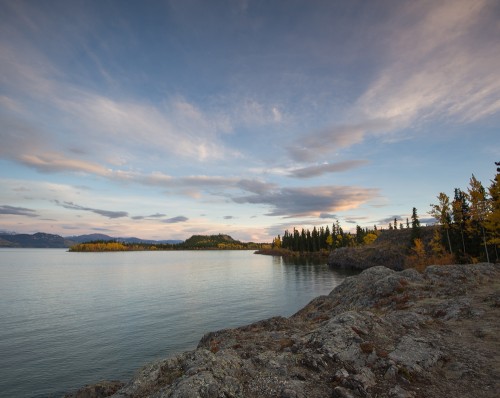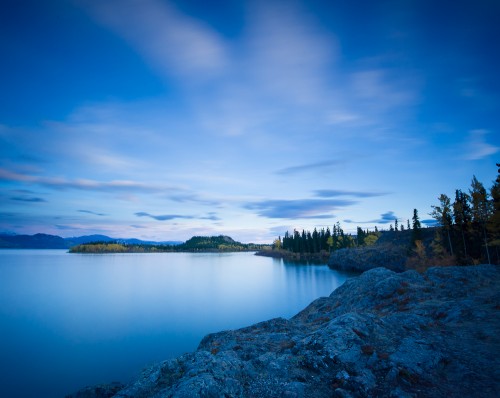Apart from a difference in timing, these two images might have been identical. What separates them, in terms of their aesthetic, is a difference in five minutes, and ten f/stops. The second image was made just five minutes after the first frame, but with the addition of the Lee Big Stopper, a 10-stop ND filter that took my exposure from 1/5s to 30s, registering the blues differently, and blurring the sky and the water. I could make the colour balance on both images a little closer, but I’ve done very little to these images in Lightroom to keep the illustration as helpful as possible and avoid a discussion about post-processing. While one is not better per se, than the other, the mood is very different from one to the other, and so will be the experience of the person reading your photograph.



Comments
Nice article and alsof nice pictures. I was looking to the exposure times and checked them in my Lee app on my phone. When I select 1/5 seconds the app says 3 minutes and 20 seconds. A big difference in exposure. My 10 stops more than 1/5 sounds 3m20s to me. Where am I wrong?
Hi David,
the photograph above is very beautiful!
A 10 stop ND filter is currently on my shopping list do you recommend the screw in kind or the glass plate?
I love long exposures but the big stopper gives me more grief than anything else. I still have not mastered controlling it’s vignette or flare. Maybe I’m just spoiled from the no-light leak of screw on filters.
It’s a finnicky filter, for sure, but I’m enjoying the learning curve. Do you have a screw-on 10-stop ND filter, Stephen? I haven’t seen one. I like that mine plays nicely with the other Lee-system filters, but there have been frames with some odd abberations. I shoot in forced 4:5 on my Nikon so the vignetting is not really an issue, but the flare can be brutal…
I do not. B+W makes one but my current go-to filter has been a 6-stop B+W. I really like it but it also has usage problems and continues to get stuck on the polarizer. Double stacked filters are good to 24-26mm and it means hand holding grads.
Had a cokin-p system with hi-tech filters but I’m very new (talking months) to the Lee system (3-stop / 10-stop / couple grads) and it’s an adjustment for sure. I only have the vignette issue from the foam gasket at very wide angles but the bigger problem is controlling or at least learning to predict when flare will be a problem so I don’t find out after several minutes of waiting. I’ll eventually figure out something that works for me.
wow. stunning difference.
Pingback: Things You’ll Find Interesting October 3, 2012 | Chuq Von Rospach, Photographer and Author
One other point on the SIngh-Ray Vari-ND, which I own: if you want to be able to screw additional filters or a perhaps a Lee filter holder on the front of the Vari-ND in order to add ND grads as well, then you need to buy the Vari-ND in standard depth with the screw mount on the front – the thin version of the Vari-ND doesn’t have the screw mount at the front. This means you will see vignetting at fairly modest wide-angle focal lengths which may restrict the compositions you are able to achieve. So if you are a money-no-object kind of guy – or simply a big fan of ND filters – there may a place for both filters in your bag.
Thanks for the additional info. I was not sure if other filters could be attached to the Vari-ND.
David, I really like the juxtaposition of the two.
Classic sample of the message you have shared in e-books and Photographically Speaking… and doing everything I can to avoid qualitative statements, they serve as examples of how we can share our own stories in unique ways
I like the top one best it’s calm, warm. Nice feeling to the end of day.
I feel other is also great but too cold for me and not really real. My thoughts. But great photos. I am still going through your post on your trip. Really great stuff.
Hi David! Love your landscapes using the ND filter. I’m headed to Italy next week and want to experiment with ND filters. Already have a graduated ND, but do you recommend just using a 10 stop ND or would a Vari-ND Variable ND filter be an overall more useful tool?
The Vari-ND is pretty cool, though expensive. It sometimes gives mixed results because it’s essentially two polarizers working together, so it can give inconsistent results based on how wide your lens is, where the sun is, and probably what day of the week it is. The advantage is that you can put it on the lens, focus, then dial in the amount of ND you want. The straight-up 10-Stop is much more consistent, a little more finicky to use (focus first, then set focus to manual, then drop in Big Stopper, make photograph). And it’s cheaper, though hard to get a hold of. Also it introduces that blue colour cast. So there are pros and cons to both. Hope that’s helpful and not just more confusing! 🙂
Thanks David!
Nice representation of how a single photograph can represent a single point in time or elapsed time.
That is pretty amazing.
My initial thought was…whoops, wrong white balance in that shot.
Both are stunning. I personally prefer the bottom, but alas, both are beautiful.
Thanks for sharing.
Hi David. Did you also use a grad ND filter on that picture?
Eric – Yes, both frames above were also shot with a soft-transition, 3-stop graduated Neutral Density filter.
Thanks David!
Interesting. The blue shift is unexpected… sort of.
Looks reminiscent of reciprocity failure of ektachrome.
Would not have expected it in digital. UV sensitivity?
No. Lens glass blocks that. IR?
What am I missing?
Gregg – To be honest I’m not clear on the physics, but two things are at play – the first is simply the reality that the light at this time of day is bluer and the longer exposure simply exaggerates that, not unlike it does on film. More than that however, no ND filter is truly neutral – and the 10-stop is known for introducing a blue cast.
I’m a fan of the ethereal look. As a frequent “Bigstopperer” I can confirm it introduces a blue colour caste. I’m not sure if it’s complex physics or simply ‘this thing is blue’. The blue sky/water works, but blue rocks a bit much….? (personal taste). A quick WB correction in LR, global or selective, sorts it out.
Of course a ‘blue colour caste’ is one of the lesser known social groupings in India who primarily work as photographic assistants carrying filters…. I don’t have a filterwallah, but my Bigstopper does leave a blue *cast*….
Nicely played, sir! 🙂